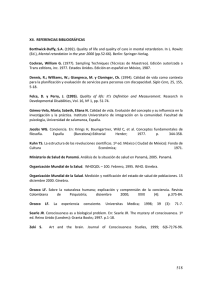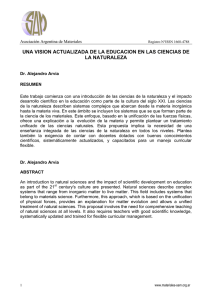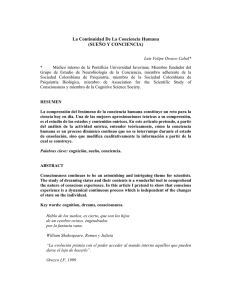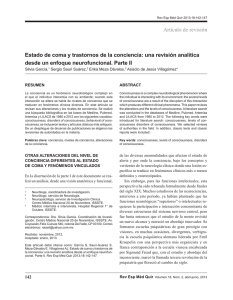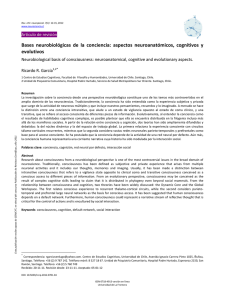Texto completo PDF - Revista Chilena de Neuropsicología
Anuncio
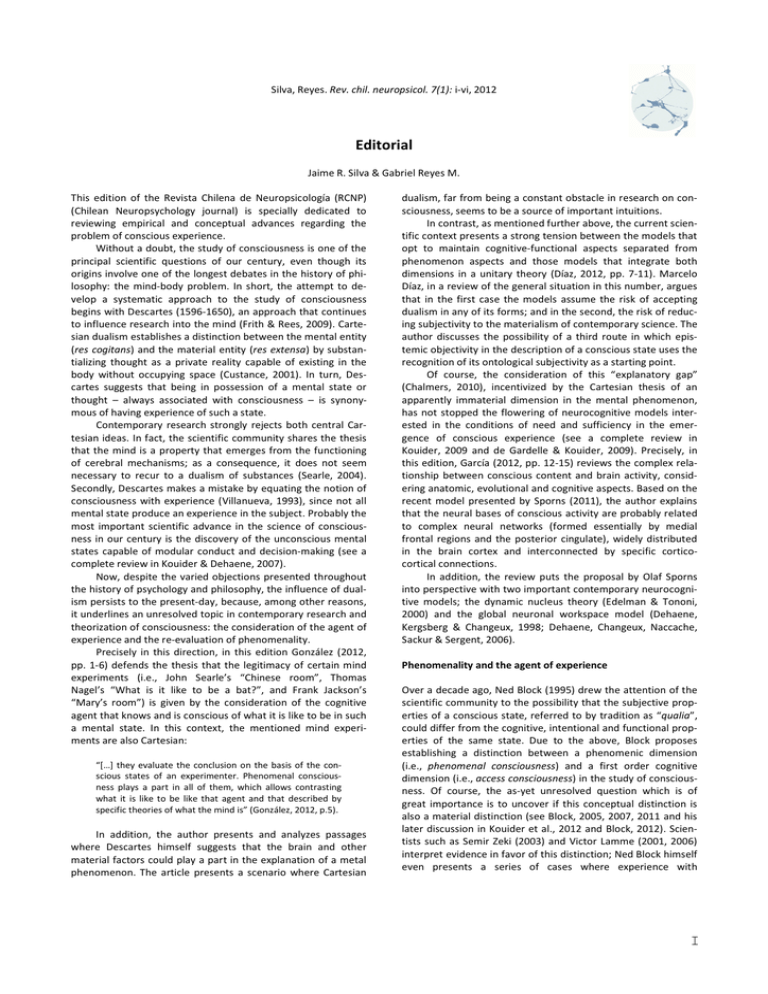
Silva, Reyes. Rev. chil. neuropsicol. 7(1): i-vi, 2012 Editorial Jaime R. Silva & Gabriel Reyes M. This edition of the Revista Chilena de Neuropsicología (RCNP) (Chilean Neuropsychology journal) is specially dedicated to reviewing empirical and conceptual advances regarding the problem of conscious experience. Without a doubt, the study of consciousness is one of the principal scientific questions of our century, even though its origins involve one of the longest debates in the history of philosophy: the mind-body problem. In short, the attempt to develop a systematic approach to the study of consciousness begins with Descartes (1596-1650), an approach that continues to influence research into the mind (Frith & Rees, 2009). Cartesian dualism establishes a distinction between the mental entity (res cogitans) and the material entity (res extensa) by substantializing thought as a private reality capable of existing in the body without occupying space (Custance, 2001). In turn, Descartes suggests that being in possession of a mental state or thought – always associated with consciousness – is synonymous of having experience of such a state. Contemporary research strongly rejects both central Cartesian ideas. In fact, the scientific community shares the thesis that the mind is a property that emerges from the functioning of cerebral mechanisms; as a consequence, it does not seem necessary to recur to a dualism of substances (Searle, 2004). Secondly, Descartes makes a mistake by equating the notion of consciousness with experience (Villanueva, 1993), since not all mental state produce an experience in the subject. Probably the most important scientific advance in the science of consciousness in our century is the discovery of the unconscious mental states capable of modular conduct and decision-making (see a complete review in Kouider & Dehaene, 2007). Now, despite the varied objections presented throughout the history of psychology and philosophy, the influence of dualism persists to the present-day, because, among other reasons, it underlines an unresolved topic in contemporary research and theorization of consciousness: the consideration of the agent of experience and the re-evaluation of phenomenality. Precisely in this direction, in this edition González (2012, pp. 1-6) defends the thesis that the legitimacy of certain mind experiments (i.e., John Searle’s “Chinese room”, Thomas Nagel’s “What is it like to be a bat?”, and Frank Jackson’s “Mary’s room”) is given by the consideration of the cognitive agent that knows and is conscious of what it is like to be in such a mental state. In this context, the mentioned mind experiments are also Cartesian: “[…] they evaluate the conclusion on the basis of the conscious states of an experimenter. Phenomenal consciousness plays a part in all of them, which allows contrasting what it is like to be like that agent and that described by specific theories of what the mind is” (González, 2012, p.5). In addition, the author presents and analyzes passages where Descartes himself suggests that the brain and other material factors could play a part in the explanation of a metal phenomenon. The article presents a scenario where Cartesian dualism, far from being a constant obstacle in research on consciousness, seems to be a source of important intuitions. In contrast, as mentioned further above, the current scientific context presents a strong tension between the models that opt to maintain cognitive-functional aspects separated from phenomenon aspects and those models that integrate both dimensions in a unitary theory (Díaz, 2012, pp. 7-11). Marcelo Díaz, in a review of the general situation in this number, argues that in the first case the models assume the risk of accepting dualism in any of its forms; and in the second, the risk of reducing subjectivity to the materialism of contemporary science. The author discusses the possibility of a third route in which epistemic objectivity in the description of a conscious state uses the recognition of its ontological subjectivity as a starting point. Of course, the consideration of this “explanatory gap” (Chalmers, 2010), incentivized by the Cartesian thesis of an apparently immaterial dimension in the mental phenomenon, has not stopped the flowering of neurocognitive models interested in the conditions of need and sufficiency in the emergence of conscious experience (see a complete review in Kouider, 2009 and de Gardelle & Kouider, 2009). Precisely, in this edition, García (2012, pp. 12-15) reviews the complex relationship between conscious content and brain activity, considering anatomic, evolutional and cognitive aspects. Based on the recent model presented by Sporns (2011), the author explains that the neural bases of conscious activity are probably related to complex neural networks (formed essentially by medial frontal regions and the posterior cingulate), widely distributed in the brain cortex and interconnected by specific corticocortical connections. In addition, the review puts the proposal by Olaf Sporns into perspective with two important contemporary neurocognitive models; the dynamic nucleus theory (Edelman & Tononi, 2000) and the global neuronal workspace model (Dehaene, Kergsberg & Changeux, 1998; Dehaene, Changeux, Naccache, Sackur & Sergent, 2006). Phenomenality and the agent of experience Over a decade ago, Ned Block (1995) drew the attention of the scientific community to the possibility that the subjective properties of a conscious state, referred to by tradition as “qualia”, could differ from the cognitive, intentional and functional properties of the same state. Due to the above, Block proposes establishing a distinction between a phenomenic dimension (i.e., phenomenal consciousness) and a first order cognitive dimension (i.e., access consciousness) in the study of consciousness. Of course, the as-yet unresolved question which is of great importance is to uncover if this conceptual distinction is also a material distinction (see Block, 2005, 2007, 2011 and his later discussion in Kouider et al., 2012 and Block, 2012). Scientists such as Semir Zeki (2003) and Victor Lamme (2001, 2006) interpret evidence in favor of this distinction; Ned Block himself even presents a series of cases where experience with I Silva, Reyes. Rev. chil. neuropsicol. 7(1): i-vi, 2012 phenomenic content (i.e., be aware) could present in the absence of representational content (i.e., be consciously aware). Precisely in the context of the distinction presented by Block, in this edition, Pereira (2012, pp. 16-20) analyzes the problem of the need for attention for phenomenal consciousness to arise. The author argues that it is possible to be phenomenally conscious of a stimulus and in turn be incapable of recording this information in the working memory. In this context, cases such as “inattentional blindness” (Mack & Rock, 1998; Simons & Chabris, 1999) are not necessarily proof of a total absence of consciousness; on the contrary, it is probable that there is only a deficiency in the mechanisms used to record the information and therefore the impossibility of a conscious report: “We may be in the presence of a case of epistemic ignorance by the observers or simply a form of consciousness that is too unstructured to be able to be used cognitively at higher levels […]” (Pereira, 2012, p. 19). Associated with the problem of phenomenality, is the reconsideration of the agent of experience in the explanation of conscious experience. Recent models in experimental psychology reconsider the importance of studying the introspective capacity of the subjects regarding the cognitive mechanism capable of describing conscious content (Corallo, Sackur, Dehaene, Sigman, 2008; Marti, Sackur, Sigman, Dehaene, 2010). The first in systematizing the thesis that consciousness is a type of mental characteristic resulting from a process of introspection or scan of past mental states was David Armstrong (1981). The models that are based on this hypothesis hold that conscience must be explained in terms of representations of mental states. A mental state reaches consciousness when the internal inspection mechanism (i.e., higher-order monitoring) produces a perceptual representation of it (i.e., higher-order perceptual representations), information which is in turn important to control of the action (see Rosenthal, 2004). By operationalizing consciousness as the product of the functioning of certain cognitive mechanisms, able to possess particular functional rules (i.e., conditions of need and sufficiency), his study can be addressed experimentally. It is important to note that the notion of introspection alluded to does not refer to a type of methodology for access to mental life, as was conceived by Wundt (1897/1999) and Titchener (1912) at the beginnings of experimental psychology (see Sackur, 2009); on the contrary, reference is made to a cognitive mechanism, present in all human primates, which is responsible for providing the subject with information regarding its own cognitive states. The importance of phenomenality and the reconsideration of the agent of experience are issues on which exploration has only recently begun in the scientific study of conscious experience, even though Descartes advised us of its importance over four centuries ago. Other topics in this volume The reconsideration of consciousness as the object of study in cognitive sciences gave rise to a series of methodological and conceptual bifurcations, e.g., interest arose regarding con- II sciousness with relation to the perception of one’s own body: exteroceptive and interoceptive awareness of the body. In this edition, Couto, Sedeño & Ibáñez (2012, pp. 21-25) argue that interoception, i.e., perception of the physiological condition of the body, is involved in the emergence of awareness of body emotional states. The authors explain that certain projections of the parasympathetic and thermoalgesic spinalthalamic-cortical tracts to the insular cortex converge in the insula, giving rise to the phenomenon of interoception. This representation of the homeostatic condition of the body triggers, in parallel, a process of regulation of behavior with affective-emotional content; a process that is essential to maintain bodily integrity and the subjective consciousness of emotions. The authors conclude by advising of the importance of associating awareness of body states to high-order cognitive and behavioral processes, given that this relationship will allow directing research towards situations in which one or both are altered. Precisely, in this number, Valenzuela (2012, pp. 26-37) presents evidence that suggests that chronic pain; cases where the condition of pain cannot be explained by peripheral damage (e.g., complex regional pain syndrome, phantom limb syndrome, fibromyalgia, etc.), have a close relationship to exteroceptive body awareness. In his thorough review, Valenzuela comments on recent research that emphasizes the role of the central nervous system in the explanation of the chronicity of the pain, and in turn discusses whether said central factors could operate to determine different forms of body awareness. Finally, Quintero & Flores (2012, pp. 38-42) examine the relationship between consciousness and meditation, with special attention to the mindfulness technique. The authors highlight the importance of considering techniques in clinical as well as experimental fields that can stimulate states of consciousness. The authors review neuroscientific evidence related to the cortical changes generated during and after a state of meditation, and discuss the possibility that said changes could be understood from the different contemporary consciousness models. The review defends the hypothesis that precise cerebral changes during the process of meditation could shed light on the electrophysiological correlates of a conscious state. Acknowledgements The authors thank Karina Jaramillo, José Cofré and Álvaro Quezada for the editorial work done and all the authors that participated in this special edition. This edition was financed through the 2010-2011 scientific journals publication fund of the National Commission of Scientific and Technological Research (CONICYT), Chile. As well as hoping to have been a platform for certain empirical and conceptual progress regarding the study of consciousness, this edition has the objective of incentivizing future publications in this multidisciplinary domain of research, in the regular RCNP edition as well as in its future special editions. Silva, Reyes. Rev. chil. neuropsicol. 7(1): i-vi, 2012 Jaime R. Silva Psychobiology Laboratory, Universidad de La Frontera, Temuco, Chile. [email protected] Gabriel Reyes Laboratoire de Sciences Cognitives et Psycholinguistique, CNRS/EHESS/DEC-ENS, Paris, France. [email protected] References Armstrong, D. (1981). The nature of mind and other essays. Ithaca, New York: Cornell University. Block, N. (1995). On a confusion about a function of consciousness. Behavioral and Brain Sciences, 18, 227-287. Block, N. (2007). Consciousness, accessibility and the mesh between psychology and neuroscience. Behavioral and Brain Sciences, 30, 481-548. Block, N. (2005). Two neural correlates of consciousness. Trends in Cognitive Sciences, 9, 46-52. Block, N. (2011). Perceptual consciousness overflows cognitive access. Trends in Cognitive Sciences, 15, 567-575. Block, N. (2012). Response to Kouider et al.: which view is better supported by the evidence? Trends in Cognitive Sciences (in press). Chalmers, D. (2010). The character of consciousness. New York: Oxford University Press. Custance A, (2001). The mysterious matter of mind. Grand Rapids, MI: Zondervan Publishing House; 1980. Corallo, G., Sackur, J., Dehaene, S., & Sigman, M. (2008). Limits on introspection: Distorted subjective time during the dual-task bottleneck. Psychological Science, 19, 1110-1117. Dehaene, S., Kerszberg, M., & Changeux, J. P. (1998). A neural model of a global workspace in effortful cognitive tasks. Proc. Natl. Acad. Sci. U.S.A, 95, 14529-14534. Dehaene, S., Changeux, J. P., Naccache, L., Sackur, J., & Sergent, C. (2006). Conscious, preconscious, and subliminal processing: a testable taxonomy. Trends In Cognitive Sciences, 10, 204-211. de Gardelle, V., & Kouider, S. (2009). Cognitive theories of consciousness. In Banks, W. (Ed.), Encyclopedia of Consciousness. Vol. 1, pp. 135-146. Oxford: Elsevier. Edelman, G., Tononi, G. (2000). El universo de la consciencia: Cómo la material se convierte en imaginación. Barcelona: Critica. Frith C., Rees G. (2007). A brief history of the scientific approach to the study of consciousness, in the Blackwell companion to consciousness. Eds. M. Velmans, S. Schneider. Blackwell Publishing, pp. 9-22. Kouider, S. (2009). Neurobiological theories of consciousness. In Banks, W. (Ed.), Encyclopedia of Consciousness. Vol. 2, pp. 87-100, Elsevier. Kouider, S., Sackur, J., de Gardelle, V. (2012). Do we still need phenomenal consciousness? Comment on Block. Trends in Cognitive Sciences (in press). Kouider, S. and Dehaene, S. (2007). Levels of processing during nonconscious perception: a critical review of visual masking. Philos. Trans. R. Soc. Lond. B. Biol. Sci. 362, 857-875. Lamme, V.A., Landman, R. (2001). Attention sheds no light on the origin of phenomenal experience. Behavioral and Brain Sciences, 24, 993993. Lamme, V.A. (2006). Towards a true neural stance on consciousness. Trends in Cognitive Sciences, 10, 494-501. Mack, A., & Rock, I. (1998). Inattentional blindness. Cambridge, MA: MIT Press. Marti, S., Sackur, J., Sigman, M., & Dehaene, S. (2010). Mapping introspection’s blind spot: Reconstruction of dual-task phenomenology using quantified introspection. Cognition, 115, 303-313. Rosenthal, D. (2004). Varieties of Higher-Order Theory, in Higher-Order Theories of Consciousness, ed. Rocco J. Gennaro, Amsterdam and Philadelphia: John Benjamins Publishers, pp. 17-44. Sporns, O. (2011). Networks of the brain. Cambridge: The MIT Press. Searle, J. (2004). Mind: a brief introduction. New York: Oxford University Press. Sackur, J. (2009). L’introspection en psychologie expérimentale. Revue d’histoire des sciences, 62, 5-28. Simons, D. J., & Chabris, C. F. (1999). Gorillas in our midst: sustained inattentional blindness for dynamic events. Perception, 28, 10591094. Titchener, E. B. (1912). The schema of introspection. American Journal of Psychology, 23, 485-508. Villanueva, E. (1993). Ciencia cognitiva y conciencia. Revista contextos, 11, 13-37. Wundt, W. M. (1999). Outlines of psychology. London: Thoemmes Press. (Original work published 1897). Zeki, S. (2003). The disunity of consciousness. Trends in Cognitive Sciences 7, 214-218. III Silva, Reyes. Rev. chil. neuropsicol. 7(1): i-vi, 2012 Editorial Jaime R. Silva & Gabriel Reyes M. El presente número de la Revista Chilena de Neuropsicología (RCNP) está especialmente dedicado a revisar avances empíricos y conceptuales en torno al problema de la experiencia conciente. Sin duda, el estudio de la conciencia constituye una de las principales interrogantes científicas de nuestro siglo, aun cuando en su origen acarrea uno de los debates de más larga data en la historia de la filosofía: el problema mente-cuerpo. En efecto, el intento de desarrollar un enfoque sistemático para el estudio de la conciencia comienza con Descartes (1596-1650), un acercamiento que continua influenciando la investigación de la mente (Frith & Rees, 2009). El dualismo cartesiano establece una distinción entre la entidad mental (res cogitans) y la entidad material (res extensa) al sustancializar el pensamiento como una realidad privada capaz de existir en el cuerpo sin ocupar espacio (Custance, 2001). A su vez, Descartes sugiere que estar en posesión de un estado mental o pensamiento –siempre asociado a la propiedad conciente– es sinónimo de tener experiencia de tal estado. La investigación contemporánea rechaza con fuerza ambas ideas centrales cartesianas. En efecto, la comunidad científica coincide en la tesis que la mente es un propiedad que emerge del funcionamiento de mecanismos cerebrales, en consecuencia, no parece necesario recurrir a un dualismo de sustancias (Searle, 2004). En segundo lugar, Descartes yerra al equiparar la noción de conciencia con la de experiencia; no toda propiedad mental produce una experiencia en el sujeto (Villanueva, 1993). Probablemente el avance científico más importante en ciencia de la conciencia de nuestro siglo sea el descubrimiento de estados mentales inconcientes capaces de modular la conducta y la toma de decisión (ver una completa revisión en Kouider & Dehaene, 2007). Ahora bien, a pesar de las diversas objeciones presentadas a través de la historia de la psicología y la filosofía, la influencia del dualismo persiste hasta la actualidad, entre otras razones, dado que subraya un tópico irresuelto en la investigación y teorización contemporánea de la conciencia: la consideración del agente de experiencia y la re-valoración de la fenomenalidad. Precisamente en esta dirección, González (2012, pp. 1-6) en este número defiende la tesis que la legitimidad de ciertos experimentos mentales (i.e., la “habitación China” de John Searle, el “What is it like to be a bat?” de Thomas Nagel y la “habitación de Mary” de Frank Jackson) está dada por la consideración del agente cognitivo que sabe y está conciente de cómo es tener tal estado mental. En este contexto, los experimentos mentales mencionados son también cartesianos: “[…] en ellos se evalúa la conclusión sobre la base de los propios estados concientes de un experimentador. En todos participa la conciencia fenoménica, la cual permite contrastar qué es ser como dicho agente y lo descrito por teorías específicas de qué es la mente” (González, 2012, p.5). IV Adicionalmente, el autor presenta y analiza pasajes donde el mismo Descartes sugiere que el cerebro y otros factores materiales pudieran participar en la explicación de un fenómeno mental. El artículo presenta un escenario donde el dualismo cartesiano lejos de ser un obstáculo constante en la investigación de la conciencia parece ser fuente de importantes intuiciones. En contraste, como se mencionó más arriba, el contexto científico actual presenta una fuerte tensión entre los modelos que optan por mantener separados aspectos cognitivofuncionales de aspectos fenoménicos y aquellos modelos que integran ambas dimensiones en una teórica unitaria (Díaz, 2012, pp. 7-11). Marcelo Díaz, en una revisión del estado del arte en este número, argumenta que en el primer caso los modelos asumen el riesgo de aceptar un dualismo en cualquiera de sus formas, en el segundo, el riesgo de reducir la subjetividad al materialismo de la ciencia contemporánea. El autor discute la posibilidad de una tercera vía en la cual la objetividad epistémica en la descripción de un estado conciente tenga como punto de partida el reconocimiento de su subjetividad ontológica. Por supuesto, la consideración de este “gap explicativo” (Chalmers, 2011), incentivado por la tesis cartesiana de una dimensión aparentemente inmaterial en el fenómeno mental, no ha detenido el florecimiento de modelos neurocognitivos interesados en describir las condiciones de necesidad y suficiencia en el surgimiento de la experiencia conciente (ver una completa revisión en Kouider, 2009; de Gardelle & Kouider, 2009). Precisamente, García (2012, pp. 12-15) en este número revisa la compleja relación entre el contenido conciente y la actividad cerebral, considerando aspectos anatómicos, evolutivos y cognitivos. En base al reciente modelo presentado por Sporns (2011), el autor explica que las bases neurales de la actividad conciente probablemente están en relación con complejas redes neurales (formada esencialmente por regiones mediales frontales y el cíngulo posterior), ampliamente distribuidas en la corteza cerebral e interconectadas por específicos canales cortico-corticales. Adicionalmente, la revisión pone en perspectiva la propuesta de Olaf Sporns con dos importantes modelos neurocognitivos contemporáneos; la teoría del núcleo dinámico (Edelman, 2000) y el modelo neural de espacio de trabajo global (Dehaene, Kergsberg, & Changeux, 1998; Dehaene, Changeux, Naccache, Sackur & Sergent, 2006). Fenomenalidad y agente de experiencia Ned Block (1995) hace más de una década llamó la atención a la comunidad científica en relación a la posibilidad que las propiedades subjetivas de un estado conciente, denominadas por la tradición “qualia”, pudieran diferir de las propiedades cognitivas, intencionales y funcionales del mismo estado. A raíz de lo anterior Block propone establecer una distinción entre una dimensión fenoménica (i.e., phenomenal consciousness) y una dimensión cognitiva de primer orden (i.e., access consciousness) Silva, Reyes. Rev. chil. neuropsicol. 7(1): i-vi, 2012 en el estudio de la conciencia (Block, 1995; 2007). Por supuesto, la cuestión aun irresuelta y de gran relevancia es develar si tal distinción conceptual es también una distinción material (ver Block, 2005, 2011 y su discusión posterior en Kouider et al., 2012, Block, 2012). Científicos como Semir Zeki (2003) y Victor Lamme (2001; 2006) interpretan evidencia a favor de esta distinción, inclusive, el mismo Ned Block (2005) presenta una serie de casos donde pudiera presentarse experiencia con contenido fenoménico (i.e., be aware) en ausencia de contenido representacional (i.e., be consciously aware). Precisamente, en el contexto de la distinción presentada por Block, Pereira (2012, pp. 16-20) en este número analiza el problema de la necesidad de la atención para el surgimiento de la conciencia fenomenal. El autor argumenta que es posible estar fenoménicamente conciente de un estimulo y a su vez ser incapaz de registrar esta información en la memoria de trabajo. En este contexto, casos como la “ceguera inatencional” (Mack & Rock, 1998; Mack, 2002; Simons & Chabris, 1999) no necesariamente son prueba de una total ausencia de conciencia, por el contrario, es probable que sólo exista un déficit en los mecanismos de registro de la información y por ende la imposibilidad de un reporte conciente: “Podríamos estar en presencia de un caso de ignorancia epistémica por parte de los observadores o simplemente de una forma de conciencia demasiado des-estructurada como para ser utilizada cognitivamente en niveles superiores” (Pereira, 2012, p. 19). En segundo lugar, asociado al problema de la fenomenalidad, está la re-consideración del agente de experiencia en la explicación de la experiencia conciente. Recientes modelos en psicología experimental reconsideran la importancia de estudiar la capacidad introspectiva de los sujetos en tanto mecanismo cognitivo capaz de describir el contenido conciente (Corallo, Sackur, Dehaene, Sigman, 2008; Marti, Sackur, Sigman, Dehaene, 2010). Uno de los primeros en sistematizar la tesis que la conciencia es un tipo de propiedad mental resultante de un proceso de inspección o scanner sobre estados mentales pasados fue David Armstrong (1981). Los modelos que se apoyan en esta hipótesis, sostiene que la conciencia debe ser explicada en términos de representaciones de estados mentales. Un estado mental alcanza la conciencia cuando el mecanismo de inspección interna (i.e., higher-order monitoring) produce una representación perceptual de este (i.e., higher-order perceptual representations), información a su vez relevante para el control de la acción (ver, Rosenthal, 2004). Al operacionalizar la conciencia como producto del funcionamiento de cierto mecanismo cognitivo, posible de poseer reglas funcionales particulares (i.e., condiciones de necesidad y suficiencia), su estudio se torna abordable experimentalmente. Importante notar que la noción de introspección aludida no refiere a un tipo de metodología para el acceso a la vida psíquica, tal como fue concebida por Wundt (1897/1999) y Titchener (1912) en los comienzos de la psicología experimental (ver Sackur, 2009), por el contrario, se hace referencia a un mecanismo cognitivo, presente en todo primate humano, responsable de proporcionar al sujeto información sobre sus propios estados cognitivos. La importancia de la fenomenalidad y la re-consideración del agente de experiencia son cuestiones que recién se comienzan a explorar en el estudio de la experiencia conciente, aun cuando Descartes hace más de cuatro siglos nos advirtió de su importancia. Otros tópicos en este volumen La reconsideración de la conciencia como objeto de estudio en ciencias cognitivas dio lugar a una serie de bifurcaciones metodológicas y conceptuales, e.g., surge el interés por la conciencia en tanto percepción del propio cuerpo: conciencia corporal exteroceptiva e interoceptiva. Couto, Sedeño & Ibáñez (2012, pp. 21-25) en este número, argumentan que la interocepción, i.e., percepción de la condición fisiológica del cuerpo, participaría en el surgimiento de la conciencia de estados emocionales corporales. Los autores explican que ciertas proyecciones de las vías parasimpáticas y termoalgésica espino-tálamo-cortical hacia la corteza insular, convergen en la ínsula dando lugar al fenómeno de interocepción. Esta representación de la condición homeostática del cuerpo desencadenaría, en paralelo, un proceso de regulación de comportamientos con contenido afectivo-emocional; proceso esencial para el mantenimiento de la integridad corporal y la conciencia subjetiva de las emociones. Los autores concluyen advirtiendo la relevancia de asociar la conciencia de estados corporales a procesos cognitivos y conductuales de alto orden, dado que esta relación permitirá dirigir la investigación a situaciones en que uno o ambos se encuentran alterados. Precisamente, Valenzuela (2012, pp. 26-37) en este número presenta evidencia que sugiere que cuadros de dolor crónico, i.e., casos donde la condición de dolor no puede ser explicada por daños periféricos (e.g., síndrome del dolor regional complejo, síndrome del miembro fantasma, fibromialgia, etc.), poseerían una estrecha relación con la conciencia corporal exteroceptiva (exteroceptive body awareness). En su completa revisión, Valenzuela comenta recientes investigaciones que enfatizan el rol del sistema nervioso central en la explicación de la cronicidad del dolor, a su vez, discute si tales factores centrales podrían operar determinando diferentes formas de conciencia corporal. Finalmente, Quintero & Flores (2012, pp. 38-42) examinan en este número la relación entre conciencia y meditación, con especial atención en la técnica mindfulness. Los autores resaltan la importancia de considerar tanto en campos clínicos como experimentales técnicas capaces de estimular estados de conciencia. Los autores revisan evidencia neurocientífica relacionada a los cambios corticales generados durante y después de un estado de meditación, a su vez discuten la posibilidad de que tales cambios pudiesen ser comprendidos desde los principales modelos contemporáneos de la conciencia. La revisión defiende la hipótesis que precisos cambios cerebrales durante el proceso de meditación pudieran dar luces sobre los correlatos electrofisiológicos de un estado conciente. V Silva, Reyes. Rev. chil. neuropsicol. 7(1): i-vi, 2012 Agradecimientos Los autores agradecen a Karina Jaramillo, José Cofré y Álvaro Quezada por la gestión editorial realizada y a todos los autores que participaron en este número especial. El presente número fue financiado a través del fondo de publicación de revistas científicas 2010-2011 de la Comisión Nacional de Investigación Científica y Tecnológica (CONICYT), Chile. Además de pretender haber sido una tribuna de ciertos avances empíricos y conceptuales en torno al estudio de la conciencia, el presente numero tiene como objetivo el incentivar futuras publicaciones en este multidisciplinario dominio de investigación, tanto en el numero regular RCNP como en sus futuros números especiales. Jaime R. Silva. Laboratorio de Psicobiología, Revista Chilena de Neuropsicología. Universidad de La Frontera, Temuco, Chile. [email protected] Gabriel Reyes Laboratoire de Sciences Cognitives et Psycholinguistique, CNRS/EHESS/DEC-ENS, Paris, France. [email protected] References Armstrong, D. (1981). The nature of mind and other essays. Ithaca, New York: Cornell University. Block, N. (1995). On a confusion about a function of consciousness. Behavioral and Brain Sciences, 18, 227-287. Block, N. (2007). Consciousness, accessibility and the mesh between psychology and neuroscience. Behavioral and Brain Sciences, 30, 481-548. Block, N. (2005). Two neural correlates of consciousness. Trends in Cognitive Sciences, 9, 46-52. Block, N. (2011). Perceptual consciousness overflows cognitive access. Trends in Cognitive Sciences, 15, 567-575. Block, N. (2012). Response to Kouider et al.: which view is better supported by the evidence? Trends in Cognitive Sciences (in press). Chalmers, D. (2010). The character of consciousness. New York: Oxford University Press. Custance A, (2001). The mysterious matter of mind. Grand Rapids, MI: Zondervan Publishing House; 1980. Corallo, G., Sackur, J., Dehaene, S., & Sigman, M. (2008). Limits on introspection: Distorted subjective time during the dual-task bottleneck. Psychological Science, 19, 1110-1117. Dehaene, S., Kerszberg, M., & Changeux, J. P. (1998). A neural model of a global workspace in effortful cognitive tasks. Proc. Natl. Acad. Sci. U.S.A, 95, 14529-14534. Dehaene, S., Changeux, J. P., Naccache, L., Sackur, J., & Sergent, C. (2006). Conscious, preconscious, and subliminal processing: a testable taxonomy. Trends In Cognitive Sciences, 10, 204-211. de Gardelle, V., & Kouider, S. (2009). Cognitive theories of consciousness. In Banks, W. (Ed.), Encyclopedia of Consciousness. Vol. 1, pp. 135-146. Oxford: Elsevier. Edelman, G., Tononi, G. (2000). El universo de la consciencia: Cómo la material se convierte en imaginación. Barcelona: Critica. VI Frith C., Rees G. (2007). A brief history of the scientific approach to the study of consciousness, in the Blackwell companion to consciousness. Eds. M. Velmans, S. Schneider. Blackwell Publishing, pp. 9-22. Kouider, S. (2009). Neurobiological theories of consciousness. In Banks, W. (Ed.), Encyclopedia of Consciousness. Vol. 2, pp. 87-100, Elsevier. Kouider, S., Sackur, J., de Gardelle, V. (2012). Do we still need phenomenal consciousness? Comment on Block. Trends in Cognitive Sciences (in press). Kouider, S. and Dehaene, S. (2007). Levels of processing during nonconscious perception: a critical review of visual masking. Philos. Trans. R. Soc. Lond. B. Biol. Sci. 362, 857-875. Lamme, V.A., Landman, R. (2001). Attention sheds no light on the origin of phenomenal experience. Behavioral and Brain Sciences, 24, 993993. Lamme, V.A. (2006). Towards a true neural stance on consciousness. Trends in Cognitive Sciences, 10, 494-501. Mack, A., & Rock, I. (1998). Inattentional blindness. Cambridge, MA: MIT Press. Marti, S., Sackur, J., Sigman, M., & Dehaene, S. (2010). Mapping introspection’s blind spot: Reconstruction of dual-task phenomenology using quantified introspection. Cognition, 115, 303-313. Rosenthal, D. (2004). Varieties of Higher-Order Theory, in Higher-Order Theories of Consciousness, ed. Rocco J. Gennaro, Amsterdam and Philadelphia: John Benjamins Publishers, pp. 17-44. Sporns, O. (2011). Networks of the brain. Cambridge: The MIT Press. Searle, J. (2004). Mind: a brief introduction. New York: Oxford University Press. Sackur, J. (2009). L’introspection en psychologie expérimentale. Revue d’histoire des sciences, 62, 5-28. Simons, D. J., & Chabris, C. F. (1999). Gorillas in our midst: sustained inattentional blindness for dynamic events. Perception, 28, 10591094. Titchener, E. B. (1912). The schema of introspection. American Journal of Psychology, 23, 485-508. Villanueva, E. (1993). Ciencia cognitiva y conciencia. Revista contextos, 11, 13-37. Wundt, W. M. (1999). Outlines of psychology. London: Thoemmes Press. (Original work published 1897). Zeki, S. (2003). The disunity of consciousness. Trends in Cognitive Sciences 7, 214-218.


